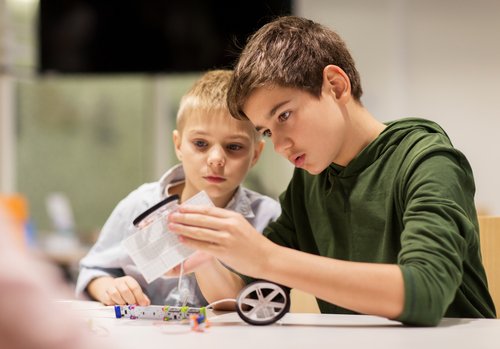How Does Laterality Develop in Children?

Laterality refers to the dominance of one side of the body over the other. In fact, this happens because one of the brain’s hemispheres declares supremacy over the other.
This concept refers to the brain’s ability to control both sides of the body. Laterality in children happens around ages 4 or 5.
To fully develop neurologically, children must have a hemispheric dominance in all functional areas. In other words, this means that if a child uses the same hand consistently, then it should also match his or her eyes, ears and legs.
Each hemisphere of the brain controls different tasks and functions. Children develop manual skills through playing and other activities. In addition, they discover what they can do with their hands.
Thus, kids begin to show laterality of their hands in functional tasks. This is because one side of their brain gains dominance. Therefore, it allows children to prefer using one hand over the other.
However, any laterality problem can cause learning difficulties in some areas. These problems can affect reading, listening, mobility, language and manual ability, especially writing.
How does laterality develop in children?
Laterality is set by school age. Between ages 2 and 5, kids use their hands to play and do many other things. Therefore, once they reach school age, they should have reached their laterality.
The truth is that the left and right hemispheres of the brain control motor action on opposite sides of the body. However, these halves aren’t equal in controlling different types of behaviors. This results in bias of one hand over the other for certain tasks.

This dominance of one hemisphere for certain behaviors is called cerebral laterality. There are clear reasons for why this characteristic evolved.
First, having a hemisphere that takes control of a process reduces the possibility that both hemispheres compete to control a response. Also, different processes like language works equally across both sides of the brain.
As they begin to develop their motor skills, children can use left and right hands equally for simple actions. For example, they work the same for reaching for objects. This is because both hands can easily perform the task.
However, for most kids, more complex tasks require specialized processing abilities. The left hemisphere is in charge of these.
“Laterality is the dominance of one side of the body over the other. This happens because one of the brain’s hemispheres declares supremacy over the other.”
How can we help children develop laterality?
The activities that contribute to developing a preferred hand are those that stimulate and help mature the cerebral pathways on both sides of the brain. It’s important to note that many of these activities should focus more on the whole body. They shouldn’t only focus on children’s hands.
Movements that involve turning, rolling, falling, swinging, and dancing stimulate the balance in parts of the brain. These play an important role in telling the brain where the body is in space. They also help with movements necessary for posture, response to stimuli and action.
Likewise, children need good balance and proper coordination for healthy brain development and dexterity. However, be careful not to overdo this type of activity.
All children have specific skills. Therefore, you need to respect their abilities and reactions.

Laterality in children: left-handed or right-handed?
According to biological psychology, laterality is the development of specialized functioning in each hemisphere of the brain or the side of the body that each one controls.
The most obvious example of laterality is how kids use their hands. It’s the tendency to use one hand or the other to perform different activities.
It’s normal to refer to people as right-handed, left-handed or ambidextrous. People are very different in the range of activities they use with a certain hand. In addition, they differ in their abilities for each hand. Most likely, no one exclusively uses only their right or left hand.
Finally, laterality in children provides a new way to better understand the relationship between brain organization, function and behavior.
Don’t be in a hurry for your child to reach these stages. Each phase gives kids the experiences they need to reach the next one.
Laterality refers to the dominance of one side of the body over the other. In fact, this happens because one of the brain’s hemispheres declares supremacy over the other.
This concept refers to the brain’s ability to control both sides of the body. Laterality in children happens around ages 4 or 5.
To fully develop neurologically, children must have a hemispheric dominance in all functional areas. In other words, this means that if a child uses the same hand consistently, then it should also match his or her eyes, ears and legs.
Each hemisphere of the brain controls different tasks and functions. Children develop manual skills through playing and other activities. In addition, they discover what they can do with their hands.
Thus, kids begin to show laterality of their hands in functional tasks. This is because one side of their brain gains dominance. Therefore, it allows children to prefer using one hand over the other.
However, any laterality problem can cause learning difficulties in some areas. These problems can affect reading, listening, mobility, language and manual ability, especially writing.
How does laterality develop in children?
Laterality is set by school age. Between ages 2 and 5, kids use their hands to play and do many other things. Therefore, once they reach school age, they should have reached their laterality.
The truth is that the left and right hemispheres of the brain control motor action on opposite sides of the body. However, these halves aren’t equal in controlling different types of behaviors. This results in bias of one hand over the other for certain tasks.

This dominance of one hemisphere for certain behaviors is called cerebral laterality. There are clear reasons for why this characteristic evolved.
First, having a hemisphere that takes control of a process reduces the possibility that both hemispheres compete to control a response. Also, different processes like language works equally across both sides of the brain.
As they begin to develop their motor skills, children can use left and right hands equally for simple actions. For example, they work the same for reaching for objects. This is because both hands can easily perform the task.
However, for most kids, more complex tasks require specialized processing abilities. The left hemisphere is in charge of these.
“Laterality is the dominance of one side of the body over the other. This happens because one of the brain’s hemispheres declares supremacy over the other.”
How can we help children develop laterality?
The activities that contribute to developing a preferred hand are those that stimulate and help mature the cerebral pathways on both sides of the brain. It’s important to note that many of these activities should focus more on the whole body. They shouldn’t only focus on children’s hands.
Movements that involve turning, rolling, falling, swinging, and dancing stimulate the balance in parts of the brain. These play an important role in telling the brain where the body is in space. They also help with movements necessary for posture, response to stimuli and action.
Likewise, children need good balance and proper coordination for healthy brain development and dexterity. However, be careful not to overdo this type of activity.
All children have specific skills. Therefore, you need to respect their abilities and reactions.

Laterality in children: left-handed or right-handed?
According to biological psychology, laterality is the development of specialized functioning in each hemisphere of the brain or the side of the body that each one controls.
The most obvious example of laterality is how kids use their hands. It’s the tendency to use one hand or the other to perform different activities.
It’s normal to refer to people as right-handed, left-handed or ambidextrous. People are very different in the range of activities they use with a certain hand. In addition, they differ in their abilities for each hand. Most likely, no one exclusively uses only their right or left hand.
Finally, laterality in children provides a new way to better understand the relationship between brain organization, function and behavior.
Don’t be in a hurry for your child to reach these stages. Each phase gives kids the experiences they need to reach the next one.
All cited sources were thoroughly reviewed by our team to ensure their quality, reliability, currency, and validity. The bibliography of this article was considered reliable and of academic or scientific accuracy.
- Pi, M. C. M., & Masià, J. R. (2015). Influencia de la edad y el género en los fenotipos y coeficientes de lateralidad en niños de 6 a 15 años. Apunts. Educación física y deportes, 2(120), 11-18. https://www.raco.cat/index.php/ApuntsEFD/article/view/296019
- Alfaro Sánchez, J. S., & Paucar Santos, J. (2008). Juegos psicomotores en el desarrollo de la lateralidad en niños y niñas de 5 años de la institución educativa 409 de San Martín–El Tambo. http://repositorio.uncp.edu.pe/handle/UNCP/2492
- Flores Mendoza, G. C. (2020). Psicomotricidad gruesa en el desarrollo de la lateralidad en niños de 4 a 5 años (Bachelor’s thesis, Universidad de Guayaquil-Facultad de Filosofía, Letras y Ciencias de la Educación). http://repositorio.ug.edu.ec/handle/redug/48964
This text is provided for informational purposes only and does not replace consultation with a professional. If in doubt, consult your specialist.








